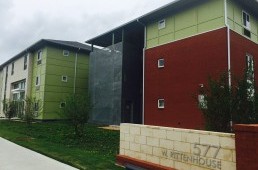
July 10, 2020 | by Michael Wilt
Categories: Affordable Housing, Homelessness, Rental Housing
This post was originally published on July 8, 2016. We felt this entry merited reposting in order to highlight the work we're doing around Permanent Supportive Housing, one portion of the affordable housing spectrum.
The affordable rental housing world includes a spectrum of housing and with that comes a glossary of terms used to label each type of housing. In this blog entry, we explain the most common types of housing that dot the affordable rental housing landscape.
Transitional Housing
This is temporary housing that offers a short-term living facility, generally for people experiencing homelessness or at risk of homelessness, until a resident can transition into longer term housing.
Permanent Supportive Housing
These communities, like the one pictured at the top, provide long term housing and supportive services for people with fixed-incomes, disabilities or issues with housing stability. Permanent Supportive Housing can be Single Room Occupancy (SRO) with a single tenant occupying a one or two room unit, or it can offer more traditional family units with several bedrooms. TSAHC offers grants to operators of Permanent Supportive Housing program for supportive services as part of our Texas Foundations Fund.
In June 2020, TSAHC announced the Texas Supportive Housing Institute, a new initiative in partnership with the Corporation for Supportive Housing. This virtual initiative will be conducted free of charge for participating development teams and will provide technical assistance to developers, service providers, and property managers interested in creating and operating supportive housing in their communities.
If you're interested in learning more about this institute and how to participate, visit our supportive housing institute web page. If you're interested in applying, we invite you to download the institute brochure and application. The deadline to apply is Wednesday, July 22nd.
Public Housing
Public housing can range from scattered single family houses to low-, mid-, and high-rise apartments and provides housing for low-income families, the elderly and persons with disabilities. The housing is owned and managed by local public housing authorities (PHAs), with aid from the U.S. Department of Housing and Urban Development (HUD).
Housing Choice Voucher Program
Authorized under Section 8 of the Housing Act of 1937, this rental assistance program is administered by local public housing authorities and provides housing vouchers to eligible tenants. It is the most common housing assistance provided to very low-income households.
There are two types of vouchers. Tenant-based vouchers allow tenants to rent from a private owner that accepts vouchers. Project-based vouchers are for developments where some or all of the units are reserved for very low-income residents. In both cases, a subsidy is paid to the landlord by the PHA on behalf of the tenant. The tenant then pays the difference between the actual rent charged by the landlord and the amount subsidized by the program.
Mixed-Income Housing
Mixed-income developments can vary broadly. These communities can include mostly market rate units with a limited number of units designated for low-income households. Or, the development may have very few market rate units with most units set aside for low-income tenants.
The ratio and make up of income levels at mixed-income developments will generally be driven by local government policies, such as inclusionary zoning requirements, or requirements of funding sources, such as Low-Income Housing Tax Credits and tax-exempt housing bonds. TSAHC has the authority to issue tax-exempt bonds that are purchased by private investors to construct housing that meets one of our four targeted housing needs.
This is not an exhaustive list of the types of affordable housing communities that exist or the income restrictions associated with each type. It merely provides a basic guide to understanding the array of affordable rental properties.
On the House blog posts are meant to provide general information on various housing-related issues, research and programs. We are not liable for any errors or inaccuracies in the information provided by blog sources. Furthermore, this blog is not legal advice and should not be used as a substitute for legal advice from a licensed professional attorney.
TSAHC reviews all blog comments before they are posted to ensure a positive experience for our online community. Off-topic comments; hostile, derogatory or deliberately insulting comments; and comments specifically promoting goods and services will not be posted.
Approved comments will be published in their entirety. Personal information will not be removed unless it pertains to someone other than the person submitting the comment. For more information, please see our Comment Posting Guidelines.
To remove a previously submitted and published comment, please contact Anna Orendain at [email protected].
If you have a question regarding any of TSAHC's programs, please contact us.
